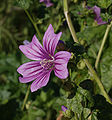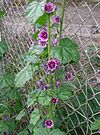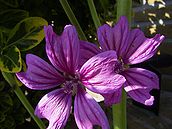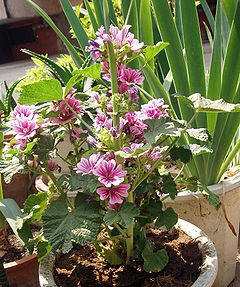- Malva sylvestris
-
Malva sylvestris 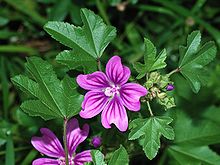
Type species for Malva L. Scientific classification Kingdom: Plantae (unranked): Angiosperms (unranked): Eudicots (unranked): Rosids Order: Malvales Family: Malvaceae Subfamily: Malvoideae Genus: Malva Species: M. sylvestris Binomial name Malva sylvestris
L. (1753)Synonyms Malva ambigua Guss.
Malva mauritiana L.
Malva erecta C.Presl[1]
Malva gymnocarpa Pomel[2]Malva sylvestris is a species of the Mallow genus Malva in the family of Malvaceae and is considered to be the type species for the genus. Known as common mallow to English speaking Europeans,[3] it acquired the common names of cheeses, high mallow and tall mallow (mauve des bois by the French)[4] as it migrated from its native home in Western Europe, North Africa and Asia through the English speaking world.[5] M. sylvestris is a vigorously healthy plant with showy flowers of bright mauve-purple, with dark veins; a handsome plant, often standing 3 or 4 feet (1 m) high and growing freely in fields, hedgerows and in fallow fields.[6]
Contents
Gallery
Common names
- Hebrew: חלמית כחולה
- Arabic: الخبيزة البرية، الخبازي، الخباز
- Azerbaijani: Əməköməci
- English: tall mallow, common mallow, high mallow, blue mallow, cheese-cake,
pick-cheese, round dock, country-mallow, wild mallow, wood mallow - Catalan: Malva, Vauma, malva de cementiri
- Corsican: Malba
- Welsh: Hocysen Gyffredin
- Czech: sléz lesní
- Danish: Almindelig Katost
- German: Kultur-käsepappel
- Esperanto: Malvo granda
- Greek: μολόχα
- Spanish: Malva común, Malva silvestre
- Basque: ziga, zigiña
- Estonian: mets-kassinaeris
- French: Grande mauve, mauve sylvestre, mauve des bois
- Finnish: Kiiltomalva
- Croatian: Sljez crni, Sljez divlji
- Hungarian: Erdei mályva, mályva, Papsajt
- Italian: Malva, méiba, nalba, riondella
- Kashmiri: Sotsal
- Malayalam: Hobbejza tar-raba
- Dutch: Groot Kaasjeskruid
- Norwegian: Apotekerkattost
- Polish: Ślaz dziki
- Portuguese: Malva silvestre
- Sardinian: mamarutza, marmaredda, marva, Narbedda
- Slovak: slez lesný
- Slovene: Gozdni slezenovec
- Serbian: crni slez
- Swedish: rödmalva
- Romanian: Nalba de culturä, nalba de padure
- Turkish: Ebegümeci
It is one of several species of different genera sometimes referred to as Creeping charlie, a term more commonly applied to Glechoma hederacea (ground ivy).[11]
Description
Malvus sylvestris is a spreading[3] herb,[12] which is an annual in North Africa,[7] biennial[5][8] in the Mediterranean[7] and a perennial elsewhere[7][12] Three feet (one meter) tall,[3][6] (3 meters has been observed in a wild or escaped from cultivation setting, and several cultivated plants of 2 meter or more in height[7]) with a growth habit which can be straight[8] or decumbent,[3][12] branched and covered with fine soft hairs or none at all,[8] M. sylvestris is pleasing in appearance when it first starts to flower, but as the summer advances, "the leaves lose their deep green color and the stems assume a ragged appearance".[6]
- Stems and leaves
- A thick, round and strong stem.[6]
- The leaves are borne upon the stem,[6] are roundish,[3][6][12] and have three[5] or five to seven[6][12] or five to nine[8] shallow[3] lobes, each 2 to 4 centimeters (1 to 2 inches) long, 2 to 5 centimeters wide (1 to 2 inches)[5] and 5 to 10 centimeters (2 to 4 inches) in diameter.[12] Downy, with hairs radiating from a common center and prominent veins on the underside.[6]
- Petiole either 2 to 6 centimeters (1 to 3 inches)[5] or 2 to 13 centimeters (1 to 5 or 6 inches) long.[8][12]
- Flowers
- Described as reddish-purple,[8] bright pinkish-purple with dark stripes[3] and bright mauve-purple,[6] the flowers of Malva sylvestris appear in axillary clusters[12] of 2 to 4[5] and form irregularly and elongated along the main stem with the flowers at the base opening first.[12]
- M. sylvestris has an epicalyx (or false calyx) with oblong segments, two-thirds as long as calyx[12] or 2–3 millimeters long and 1.5 millimeters wide.[5] Its calyx is free to the middle, 3–6 millimeters long,[5] with broadly triangular lobes[5] or ovate mostly 5–7 millimeters long.[12] The flowers are 2–4 times as long as the calyx;[8]
- Petals are wrinkly to veined on the backs,[8] more than 20 millimeters long[3] or 15 to 25 millimeters long [12] and 1 centimeter wide,[5] eggshaped, margin notched with a fringe of hairlike projections.[5]
- Ten broad carpels in axillary clusters;[8] stamen about 3 millimters long, radiating from the center with short soft hairs.[5]
 Fruit
Fruit
- Fruits
- Nutlets strongly reticulate (10–12 mericarps, usually without hair, with sharp angle between dorsal and lateral surfaces, 5–6 millimters in diameter.[3][5]
- Seeds or 'cheeses,'[6] are brown to brownish green when ripe, about 2.5 millimeters long and wide[5][12] 5 to 7 millimeters in diameter[12] and are shaped like a cheese wheel which is where several of its common names came from.[citation needed]
- Chromosome number
- 2n=42.[3]
Distribution
As a native Malva sylvestris spreads itself on waste and rough ground, by roads and railways throughout lowland England, Wales and Channel Islands, Siberia and scattered elsewhere.[3][8] It has been introduced to and has become naturalised in eastern Australia,[12] in the United States, Canada and Mexico probably escaped from cultivation.[8]
- Native
- Palearctic:
- Macaronesia: Azores, Madeira Islands
- Northern Africa: Algeria, Egypt, Libya, Morocco
- Arabian Peninsula: Saudi Arabia
- Western Asia: Afghanistan, Cyprus, Sinai, Iran, Israel, Jordan, Lebanon, Syria, Turkey
- Caucasus: Armenia, Azerbaijan, Ciscaucasia, Dagestan, Georgia
- Soviet Middle Asia: Kyrgyzstan, Tajikistan, Turkmenistan, Uzbekistan
- Mongolia: Mongolia
- China: Xinjiang
- Indian Subcontinent: Bhutan, India, Pakistan
- Northern Europe: Denmark, Finland, Ireland, Norway, Sweden, United Kingdom
- Middle Europe: Austria, Belgium, Czech Republic, Germany, Hungary, Netherlands, Poland, Slovakia, Switzerland
- East Europe: Belarus, Central Russia, Central Black Earth, Estonia, Latvia, Lithuania, Moldova, Northern Russia, North Caucasus, Northwestern Russia, Volga, Urals, Volga-Vyatka, Ukraine
- Southeastern Europe: Albania, Bosnia and Herzegovina, Bulgaria, Croatia, Greece, Italy, Macedonia, Montenegro, Sardinia, Serbia, Sicily, Slovenia, Romania
- Southwestern Europe: Balearic Islands, Corsica, France, Portugal, Spain
Source: USDA ARS GRIN[4]
Uses
In 1931 Maud Grieve wrote that the "use of this species of Mallow has been much superseded by Marsh Mallow (Althaea officinalis), which possesses its valuable properties in a superior degree, but it is still a favourite remedy with country people where Marsh Mallow is not obtainable," making this section more about history as it is about uses.[6]
- Decoration
- In the past, the flowers were spread on doorways and woven into garlands or chaplets for celebrating May Day.[6]
- Food
- The young leaves when boiled is a wholesome vegetable[6] and was (1841) eaten in several parts of Europe;[13] however, cattle do not seem to enjoy it and graze around them.[6]
- Medicinal
Mucilage is present in many of the Malvaceae family,[14] especially the fruit[15] and were employed medicinally, as demulcents and emollients.[16] The seeds were used internally in a decoction as a demulcent and diuretic[13][15] and the leaves made into poultices as an emollient for external applications.[15]
The name comes from latin malva meaning soft ("molle", i.e. capable of softening). It is used in phytotherapy: the active ingredients are found in the flowers and leaves, which are rich in mucillage, used for their emollinet and expectorant properties, in chatarrh forms of the upper airways. The plant is largely used as emolliente and to sooth mucous membranes inflammations. Mallow can be takes as a herbal tea to hydrate and soften the guts[citation needed], and to regulate its functions due to its laxative action, due to the mucilage properties of swelling the guts, stimultaing their contractions and hence easing the emptying thereof[citation needed].
- Other
- The species has long been used as a natural yellow dye,[17] perhaps more recently, cream color, yellow and green dyes can be obtained from the plant and the seeds.[18] A tincture of the flowers can make a very sensitive test for alkalis.[6]
Subspecies
Plants previously often described as Malva sylvestris var. malaca are now considered a Cultivar Group Malva sylvestris Mauritiana Group.[7]
Cultivation
It is often grown as an ornamental plant for its attractive flowers, produced for a long period through the summer. Numerous cultivars have been selected and named.
Cultivars of Malva sylvestris include: 'Alba', 'Annita', 'Aurora', 'Bardsey Blue', 'Blue Fountain', 'Brave Heart', 'Cottenham Blue', 'Gibbortello', 'Harry Hay', 'Highnam', 'Inky Stripe', 'Knockout', 'Magic Hollyhock', 'Mest', 'Mystic Merlin', 'Perry's Blue', 'Purple Satin', 'Richard Perry', 'Tournai', 'Windsor Castle', 'Zebrina' (soft lavender-purple striped with deep maroon veins) [19] and 'Zebrina Zebra Magis'.
- Cultivar Groups
-
- Malva sylvestris L. Mauritiana group
- Swedish: mauretansk rödmalva, Estonian: mauri kassinaeris, Slovene: Mavretanski slezenovec, Croatian: mórmályva Malva mauritiana used to be recognized as a species whose range is Iberia, Italy and Algeria. Garden plants are often called Malva sylvestris var. mauritiana and they make a cultivar group that includes:
- 'Bibor Felho'
- 'Moravia'
-
- Malva sylvestris L. Eriocarpa group
- Hairy seeds and hairy stems found between Italy and the Himalayas, Central Asia and China.
-
- Malva sylvestris L. Canescens group
- Every part except for the flower is covered with dense white woolly hair, growing in the Montpellier region of France, and on the Balearic Isles. Some 19th century botanical works called this group Malva sylvestris L. var. canescens.
-
- Malva sylvestris L. Sterile Blue group
- Vegetatively propagated pale violet-blue flowered cultivars:
- MARINA 'Dema'
- 'Primley Blue'
Source: Stewart Robert Hinsley[7]
- Virus
- Malva vein clearing potyvirus which is transmitted by mechanical inoculation in a non-persistent manner via insects: Aphis umbrella (syn. Aphis malvae Koch) and Myzus persicae (all are Aphididae). The virus can be found in Tasmania, Brazil, the former Czechoslovakia, Germany, Israel, Italy, Portugal, California, Russia and the former Yugoslavia.[20][21]
References
- ^ "Flora Europaea Search Results". Flora Europaea. Royal Botanic Garden Edinburgh. http://rbg-web2.rbge.org.uk/cgi-bin/nph-readbtree.pl/feout?FAMILY_XREF=&GENUS_XREF=Malva&SPECIES_XREF=sylvestris. Retrieved 9 May 2008.
- ^ "Malva sylvestris L. record n° 81830". African Plants Database. South African National Biodiversity Institute, the Conservatoire et Jardin botaniques de la Ville de Genève and Tela Botanica. http://www.ville-ge.ch/cjb/bd/africa/details.php?langue=an&id=81830. Retrieved 9 May 2008.
- ^ a b c d e f g h i j k "Malva sylvestris (Mallow, Common)". Interactive Flora of NW Europe. Netherlands Biodiversity Information Facility. http://ip30.eti.uva.nl/BIS/flora.php?selected=beschrijving&menuentry=soorten&id=2138. Retrieved 9 May 2008.
- ^ a b Germplasm Resources Information Network (GRIN) (20 May 1992). "Taxon: Malva sylvestris L.". Taxonomy for Plants. USDA, ARS, National Genetic Resources Program, National Germplasm Resources Laboratory, Beltsville, Maryland. http://www.ars-grin.gov/npgs/cgi-bin/npgs/html/taxon.pl?23307. Retrieved 9 May 2008.[dead link]
- ^ a b c d e f g h i j k l m n o Flora of Pakistan. Malva sylvestris Linn.. http://www.efloras.org/florataxon.aspx?flora_id=5&taxon_id=220008088. Retrieved 9 May 2008.
- ^ a b c d e f g h i j k l m n o p M. Grieve (1931). "MALLOW, BLUE". A Modern Herbal. © Copyright Protected 1995–2008 Botanical.com. http://www.botanical.com/botanical/mgmh/m/mallow07.html#blu. Retrieved 10 May 2008.
- ^ a b c d e f g Stewart Robert Hinsley. "Malva sylvestris (section Malva, in part)". The Malva Pages. http://www.malvaceae.info/Genera/Malva/sylvestris.php. Retrieved 9 May 2008.
- ^ a b c d e f g h i j k l m Britton, Nathaniel; Addison Brown (1913). "CYRILLACEAE". An illustrated flora of the northern United States, Canada and the British possessions. Volume II, Amaranthaceae to Loganiaceae. Charles Scribner's Sons. pp. 2052 pages. http://books.google.com/books?id=RZUCAAAAYAAJ&pg=PA514&as_brr=1#PPA514,M1. Retrieved 10 May 2008.
- ^ McDowell Patterson, Austin (1921). "Section 9 labdanum, liniment, yeast". A French-English dictionary for chemists. John Wiley & Sons. pp. 384 pages. http://books.google.com/books?id=vIU6AAAAMAAJ&pg=PA222. Retrieved 10 May 2008.
- ^ Murphy, Stephen D. (14 January 2004). "A DATABASE OF FLORA OF NORTHEASTERN CANADA/U.S.". University of Waterloo. http://www.fes.uwaterloo.ca/ers/faculty/documents/Smurphbot.pdf. Retrieved 10 May 2008.
- ^ Sinclair, Pam (7 October 1999). "creeping charlie". Plantbio mailing list mailing list. http://www.bio.net/bionet/mm/plantbio/1999-October/021768.html. Retrieved 10 May 2008.
- ^ a b c d e f g h i j k l m n o p National Herbarium of New South Wales. "Search PlantNET". New South Wales FloraOnline. Royal Botanic Gardens, Sydney. http://plantnet.rbgsyd.nsw.gov.au/cgi-bin/NSWfl.pl?page=nswfl&lvl=sp&name=Malva~sylvestris. Retrieved 9 May 2008.
- ^ a b Hiley, John S. (1841). "On the medical botany of the province of Halifax". In Thomas Wakley. The Lancet, In Two Volumes (Volume The Second ed.). J. Onwhyn. http://books.google.com/books?id=8v0BAAAAYAAJ&pg=PA430. Retrieved 10 May 2008.
- ^ Balfour, John Hutton (1863). "Products and Secretions of Plants". A manual of botany: being an introduction to the study of the structure, physiology, and classification of plants. Edinburgh: A & C Black. http://books.google.com/books?id=SAsAAAAAQAAJ&pg=RA1-PA385. Retrieved 10 May 2008.
- ^ a b c Dey, William Mair, Kanny Lall; William Mair (1896). "Indigenous Drugs of India". The indigenous drugs of India: short descriptive notices of the principal medicinal products met with in British India. Thacker, Spink & Co.. pp. 387 pages. http://books.google.com/books?id=3vgIAAAAIAAJ&pg=PA180. Retrieved 10 May 2008.
- ^ Balfour, John Hutton (1863). "Malvaceae". A manual of botany: being an introduction to the study of the structure, physiology, and classification of plants. Edinburgh: A & C Black. http://books.google.com/books?id=SAsAAAAAQAAJ&pg=RA1-PA385. Retrieved 10 May 2008.
- ^ Bailey, Liberty Hyde (1910). "Dyes and Dyeing. C.S. Doggert". Cyclopedia of American agriculture: a popular survey of agricultural conditions, practices and ideals in the United States and Canada, In Four Volumes. Volume II --Crops. Macmillan Publishers. pp. 2016 pages. http://books.google.com/books?id=ljiucRg4skwC&pg=PA268. Retrieved 10 May 2008.
- ^ "Malva sylvestris L.". Plants For A Future. http://www.pfaf.org/database/plants.php?Malva+sylvestris. Retrieved 10 May 2008.
- ^ Heritage Perennials: Malva sylvestris 'Zebrina'
- ^ "00.057.0.81.049. Malva vein clearing virus". ICTVdB Management. The Universal Virus Database Columbia University. 2006. http://www.ncbi.nlm.nih.gov/ICTVdb/ICTVdB/00.057.0.81.049.htm. Retrieved 10 May 2008.
- ^ "Descriptions and Lists from the VIDE Database: Malva vein clearing potyvirus". Plant Viruses Online. University of Idaho. August 1996. http://image.fs.uidaho.edu/vide/descr479.htm. Retrieved 10 May 2008.
External links
 Media related to Malva sylvestris at Wikimedia Commons
Media related to Malva sylvestris at Wikimedia Commons  Data related to Malva sylvestris at Wikispecies
Data related to Malva sylvestris at Wikispecies This article incorporates text from the public domain 1913 Webster's Dictionary.
This article incorporates text from the public domain 1913 Webster's Dictionary.- UniProt. "Malva sylvestris" (HTML). http://beta.uniprot.org/taxonomy/145754. Retrieved 10 May 2008.
- Africa
-
- "Malva sylvestris L. record n° 81830". African Plants Database. South African National Biodiversity Institute, the Conservatoire et Jardin botaniques de la Ville de Genève and Tela Botanica. http://www.ville-ge.ch/cjb/bd/africa/details.php?langue=an&id=81830. Retrieved 9 May 2008.
- Aluka. "Malva sylvestris L. [family MALVACEAE"]. African Plants. Ithaka Harbors, Inc. doi:10.5555/AL.AP.COMPILATION.PLANT-NAME-SPECIES.MALVA.SYLVESTRIS. http://www.aluka.org/action/showCompilationPage?doi=10.5555/AL.AP.COMPILATION.PLANT-NAME-SPECIES.MALVA.SYLVESTRIS. Retrieved 10 May 2008.
- Australia
-
- "Malva sylvestris L.". Australian Plant Name Index (APNI), IBIS database. Centre for Plant Biodiversity Research, Australian Government. http://www.anbg.gov.au/cgi-bin/apni?taxon_id=5384.
- National Herbarium of New South Wales. "Search PlantNET". New South Wales FloraOnline. Royal Botanic Gardens, Sydney. http://plantnet.rbgsyd.nsw.gov.au/cgi-bin/NSWfl.pl?page=nswfl&lvl=sp&name=Malva~sylvestris. Retrieved 9 May 2008.
- Australian New Crops Program (30 January 2001). "Listing of Useful Plants of the World". Australian New Crops. University of Queensland. http://www.newcrops.uq.edu.au/listing/malvasylvestris.htm. Retrieved 10 May 2008.
- Canada
-
- sylvestris "Malva sylvestris L.". E-Flora BC: Electronic Atlas of the Plants of British Columbia. University of British Columbia Herbarium. http://linnet.geog.ubc.ca/Atlas/Atlas.aspx?sciname=Malva sylvestris. Retrieved 10 May 2008.
- Murphy, Stephen D. (14 January 2004). "A DATABASE OF FLORA OF NORTHEASTERN CANADA/U.S.". University of Waterloo. http://www.fes.uwaterloo.ca/ers/faculty/documents/Smurphbot.pdf. Retrieved 10 May 2008.
- Europe
-
- "Flora Europaea Search Results". Flora Europaea. Royal Botanic Garden Edinburgh. http://rbg-web2.rbge.org.uk/cgi-bin/nph-readbtree.pl/feout?FAMILY_XREF=&GENUS_XREF=Malva&SPECIES_XREF=sylvestris. Retrieved 9 May 2008.
- "Malva sylvestris". The Linnean Collections. Linnean Society of London. http://www.linnean-online.org/8057/. Retrieved 10 May 2008.
- "Malva sylvestris Malvaceae Common Mallow". Flora of Northern Ireland. http://www.habitas.org.uk/flora/species.asp?Item=3131. Retrieved 10 May 2008.
- Israel
-
- Flora of Israel Online. "Malva sylvestris L.". Hebrew University of Jerusalem. http://www.flora.huji.ac.il/browse.asp?action=specie&specie=MALSYL. Retrieved 10 May 2008.
- "Malva sylvestris". Jerusalem Botanical Gardens. http://www.botanic.co.il/a/catalog.asp?qcat=MALSYL. Retrieved 10 May 2008.[dead link]
- New Zealand
-
- Greater Wellington Regional Council. "Large-flowered mallow (Malva sylvestris)". Controlling problem weeds in riparian zones. http://www.gw.govt.nz/large-flowered-mallow-malva-sylvestris/. Retrieved 16 May 2011.
- Pakistan
-
- Flora of Pakistan. Malva sylvestris Linn.. http://www.efloras.org/florataxon.aspx?flora_id=5&taxon_id=220008088. Retrieved 9 May 2008.
- United States
-
- "Malva sylvestris L.". Integrated Taxonomic Information System. http://www.itis.gov/servlet/SingleRpt/SingleRpt?search_topic=TSN&search_value=21840. Retrieved 10 May 2008.
- "Malva sylvestris". Natural Resources Conservation Service PLANTS Database. USDA. http://plants.usda.gov/java/profile?symbol=MASY. Retrieved 10 May 2008.
- CalPhotos. "Photo Database". University of California, Berkeley. http://calphotos.berkeley.edu/cgi/img_query?query_src=photos_index&where-taxon=Malva+sylvestris. Retrieved 10 May 2008.
- "Malva sylvestris L.". Species Information. Calflora. http://www.calflora.org/cgi-bin/species_query.cgi?where-calrecnum=5355. Retrieved 10 May 2008.
- "High Cheeseweed – Malva sylvestris". Montana Field Guides. Montana State Government. http://fieldguide.mt.gov/detail_PDMAL0R080.aspx. Retrieved 10 May 2008.
- "Database Results Dicots: Malvaceae". TENN Vascular Plants. University of Tennessee Herbarium. http://tenn.bio.utk.edu/vascular/database/vascular-database.asp?CategoryID=Dicots&FamilyID=Malvaceae&GenusID=Malva&SpeciesID=sylvestris. Retrieved 10 May 2008.
- "Malva sylvestris L.". Digital Atlas of the Virginia Flora. Virginia Tech. http://www.biol.vt.edu/digital_atlas/index.php?do=plant&plant=2987. Retrieved 10 May 2008.
- Burke Museum of Natural History and Culture. "Malva sylvestris". Vascular Plants. University of Washington. http://biology.burke.washington.edu/herbarium/imagecollection.php?Genus=Malva&Species=sylvestris. Retrieved 10 May 2008.
- Wisconsin State Herbarium. "Family – Malvaceae Taxon – Malva sylvestris L.". Wisflora – Vascular Plant Species. University of Wisconsin–Madison. http://www.botany.wisc.edu/wisflora/scripts/detail.asp?SpCode=MALSYL&Genus=Malva&Family=Malvaceae&Species=sylvestris&Common=high+mallow. Retrieved 10 May 2008.[dead link]
- Robert W. Freckmann Herbarium. "Taxon – Malva sylvestris L.". University of Wisconsin–Stevens Point. http://wisplants.uwsp.edu/scripts/detail.asp?SpCode=MALSYL. Retrieved 10 May 2008.
Categories:- Malva
- Flora of Europe
- Flora of Northern Africa
- Flora of Western Asia
- Flora of Central Asia
- Flora of Macaronesia
- Flora of the Mediterranean
- Flora of the Middle East
- Flora of Finland
- Flora of Jordan
- Demulcents
- Plant dyes
Wikimedia Foundation. 2010.



